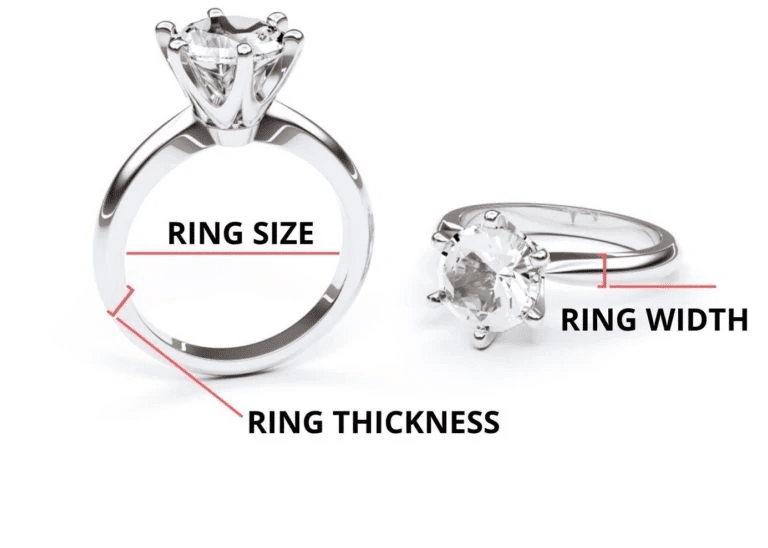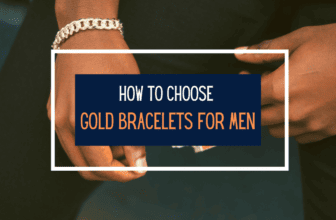
Table of Contents
When buying a ring, color, metal, budget, finish, and such factors are often what is decided on first. However, the wedding band width is a vital consideration for men. But it’s one of those things that we don’t tend to think about till the last minute.
There are several interplaying factors that you should consider when choosing men’s wedding band width. If you’re looking for information about wedding band widths for women, then check out this guide. For men’s wedding band width, keep reading.
Quick Takeaway: Thin bands suit average-sized hands and fingers, and can be comfortable, and light, while thicker bands suit larger hands, but may feel more restrictive and bulky. Choose what feels comfortable and stylish to you.
Width vs. Thickness: What’s the Difference?

First of all, let’s clear up the misconception that width and thickness are the same thing. They’re not. The above image shows the difference clearly. Ring thickness is the metal width when viewed from the side, while ring width is how wide the ring is. We’ve done an entire article on this topic, so please check it out here. In general, men’s rings tend to range between 4mm to 7mm. But some go as thin as 2mm and others reach well over 12mm.
How Hand Size Impacts Ring Width

Hand size will help you determine the best width for your ring more than any other factor. You don’t want a ring that’s too thin or too wide for your hand, because this can make both the hand and the ring look bad. A 4mm ring width, like this white gold ring, is preferable for hands on the smaller side, and a larger 6mm band width, like this classic yellow gold ring, suits for larger and wider hands.
Too slim and the ring can look lost on your hand. Too large and the ring can overpower your hand and put the sense of proportion out of balance. So with ring width, you have to go for the Goldilocks Rule – find the one that’s not too thin and not too thick, but just right.
What About Super Wide Rings?

A wider ring of up to 8mm is appropriate for men with larger hands, but the ring width should never overpower – or oversize – the hand. You want there to be some harmony between the two.
Ok, but what about those super wide rings that are trending these days? Well, these types of rings are more suited to costume jewelry. They’re gorgeous, whether for men or women, but they’re not the best option for a ring you plan to wear daily.
If you’re looking for a ring that you plan to wear often (let’s say like an engagement ring for men or a wedding ring), then it’s best to go for a thinner, more comfortable ring width. In general, stick between the classic range of 4mm to 7mm and you won’t go wrong.
What About an Embellished Ring?

If you’re looking for a ring that has a row of diamonds or some other embellishment, then you might find that a thin ring won’t cut it. The 8mm ring featured above provides a wide base for the embedded diamond jewels. In this example, the extra width is justified because of the proportion created between the white gold base and the diamonds.
An embellished ring that either has engravings, additional and complimentary metals, inlay, or jewels, can be a good reason to expand the ring’s width. In effect, the width creates proportion and space for the design. 9mm is a good upper size for such an embellished ring size. But a much larger base will only minimize the effect of the embellishment and place too much attention on the large foundation.
Don’t Forget Comfort
Another important consideration is the comfort of your wedding band. For this, it’s best to try on rings of different widths to get an idea about what you find most uncomfortable.
In general, thinner bands are more comfortable if you have smaller hands or fingers. It might feel less obtrusive. These are also lighter and not as noticeable as thicker bands. This is especially important if you’re not used to wearing jewelry.
Thicker bands are ideal if you like the feel of a heavier wedding ring. These also tend to stay in place better than thinner bands. However, they may cause your fingers to sweat more and might be restrictive, especially if you’re doing certain activities like gardening or sports. However, you won’t know until you try, as every person’s preference can be different.
Width and Masculinity

One of the clearest markers of how masculine a ring looks is its width. While modern metals like titanium and tungsten, and colors like black, come across as highly masculine because of their strength, durability, and serious connotations, it’s the ring’s width that really makes a wedding ring appear masculine or feminine.
Don’t believe us? Take a look at this 14k gold wedding ring set and this nature-inspired matching ring set. The main difference is in the widths of the rings. This is how partner rings, typically for male and females, are differentiated in most wedding ring sets.

But before you buy a ring simply because it looks ‘more masculine’ focus on how comfortable it is and whether you like how it looks. These days, anything goes and there aren’t any hard or fast rules. In fact, many couples choose matching rings of identical widths because they feel it represents equality and unity.
FAQs About Ring Width
1. What’s the average ring width for men’s wedding bands?
4mm to 6mm is the most common range. It will be harder to find sizes larger than 8mm on most jewelry retail sites.
2. Is 2mm too small for a man’s ring?
Generally, a 2mm ring band can look too small and can appear insignificant on a man’s hand. But of course, if you’re looking for a subtle ring, then go for it.
3. How do you measure a ring’s width?
GIA recommends using wide-finger sizing gauges to measure rings with a width over 4mm.
4. Does ring width affect ring size?
Yes. Wider bands tend to fit tighter than thinner bands and feel tighter too. This is because of how they sit on your finger, even if they have the same diameter as a thinner band. For wide bands, sizing up is recommended.
5. Should a man’s wedding ring be thinner than a woman’s?
Traditionally, this has been the case. However, today, some couples choose to have the same width rings.
Wrapping Up
Men’s wedding band width is dependent on the same factors that influence any ring you choose to wear – the size and width of your hands. Think about comfort when choosing your ring’s width and lifestyle. Having said that, whether embellished, matching or plain, the ring width you choose is a matter of preference, after all. Go from 2mm all the way to 12mm or even more – the choice is yours!
Related Articles
4mm vs. 6mm Men’s Wedding Bands: Which Is Better?
Why Choose a Hammered Wedding Band (Pros, Cons, & Tips)
12 Metals for Men’s Wedding Bands: Which Is the Best?









